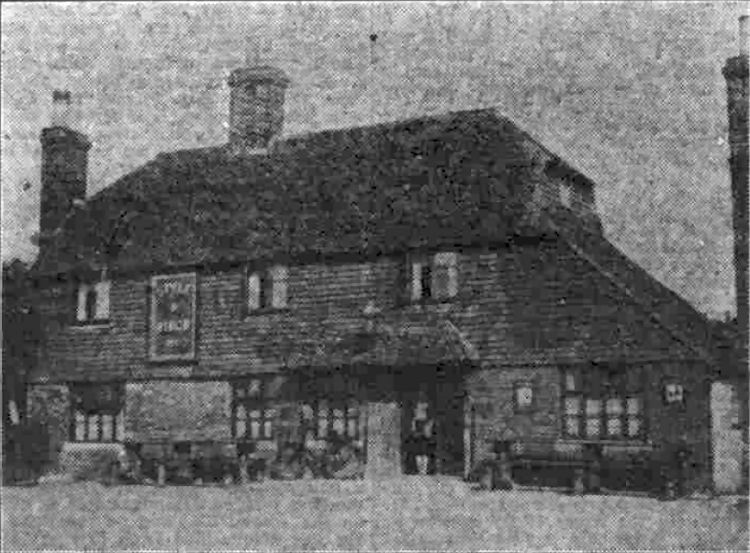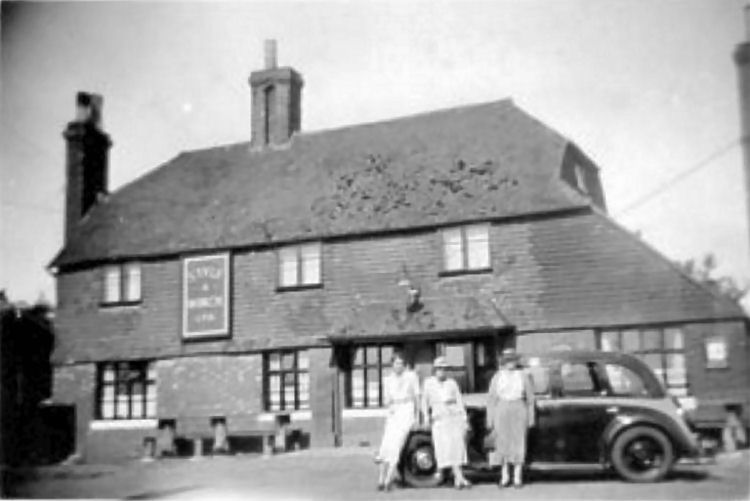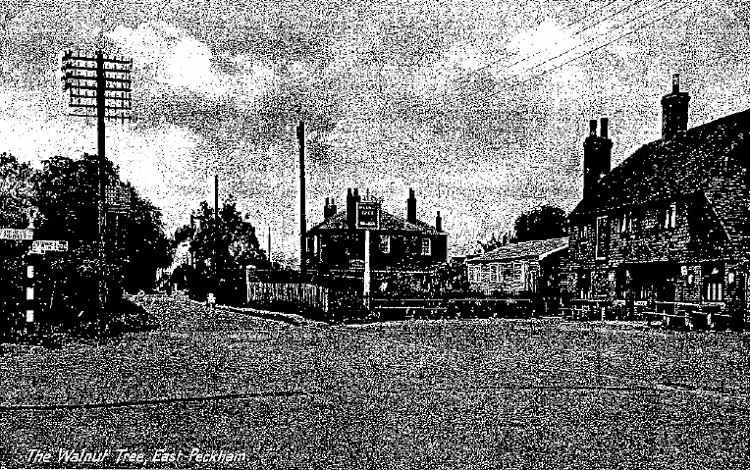|
Kent & Sussex Courier, Friday 25 September 1931.
"GHOSTLY VISITATIONS" AT EAST PECKHAM.
A Story of 150 Years' Old Curse.
OUR INVESTIGATOR’S INQUIRIES AND DEDUCTIONS.
A story of a curse laid 150 years ago by a woman who was the wife of a
landlord of an inn, who, on her death-bed, cursed her husband and his
heirs; of the lapse of about 150 years before any more was heard of the
curse; of the now ghostly visitations, sometimes in the day, at other
times at night.
In brief, this was a story which was found to be a general topic of
conversation when our representative visited the village of East Peckham
on Monday. Some people thought it a credendum; others were given to
doubts as to its credibility.
In an endeavour to find out the facts, we sent our special investigator
to the spot where the ghostly visitations were said to occur, and below
we publish the information he obtained and the deductions which he made
as a result of his inquiries.
In my investigations of a story which was in circulation in the village
of East Peckham and neighbourhood regarding the ghostly visitations of
the wife of a one-time landlord of an inn in the village, I gleaned the
information that it had been stated that a curse laid by the woman some
150 years ago had come into the limelight, and that at the present time
she pays ghostly visitations to the inn, and her footsteps are heard in
the room where she died. Further, that her gravestone has been moved,
and that these visitations are probably a sequel to the moving of that
stone.
The said inn is now occupied by Mr. W. Barrow, who is a Navy pensioner,
his last ship being H.M.S. Canterbury, from which he signed off just
after the Great War. Not quite two years ago he took over the license of
the inn, the "Walnut Tree," which is a fine old-timbered inn.
It was at the inn that I was informed that shortly after he took up
residence he, with his family and some London friends were talking in
the kitchen one day when their conversation was arrested by what seemed
to be footsteps in a room overhead. Mr. Barrow and another man
immediately dashed upstairs and flung open the door. Nothing was there!
There was no sign of anyone.
FOUR SHUFFLING STEPS.
Since that occasion, I was told, the footsteps have been heard about a
dozen times or more, and that there always seems to be four shuffling
steps across the room and four back.
A desire expressed by me to visit this haunted room was granted, and
Miss Barrow, the landlord’s daughter, took me to this room, which she
occupies. I found on pacing it out that four steps took me to the
fire-place, which is in the outer wall of the building.
Miss Barrow declared that sometimes when she entered the room it seemed
as though some unseen person was following her.
It was whilst I was subsequently talking to her mother, Mrs. Barrow,
that I was informed that there was also a story that two highwaymen were
buried at the rear of the premises, but Mrs. Barrow could not say
whether or not this story was a true one.
I next paid attention to what was said to be the gravestone. I was told
that when someone had previously touched it that at the very moment the
landlord's wife again heard the ghostly footsteps, and that to touch the
stone was apparently to summon the ghost.
NO RESULT.
Possibly I did not touch it quite correctly or in the right spot! I
turned it, rubbed it, took a paper impression of the writing on it, laid
it down, stood it up, but all without result.
I did this in the day-time, and I did it again at night when it was
pitch black, but I saw no signs of ghostly apparitions or felt an unseen
presence near me, or heard any noises.
I examined this stone very carefully. My conclusions may be wrong, but
to me this block of granite did not appear to be a memorial to anyone.
It measures about three and a half feet by nine inches by six at the
top, and is broader at the base. Obviously a portion, had been broken
from the top.
From the bases of the broken letters and the two words beneath, I
deduced the inscription, which was deeply cut, to be "Ends here. 1781."
This rather suggests a boundary stone, but whether it marked a "hundred"
boundary, or was brought there from elsewhere, one cannot be certain.
The parish boundary is more than half a mile away.
It also seems to be too narrow for a gravestone. Probably it marked the
boundary of someone’s property.
ONCE FORMED CORNER POST.
Mr. Fred Parsons, a local resident, informed me that a year or two ago a
forge stood in a corner of the inn yard, and the stone formed the corner
post of the iron fencing, and was taken up when the forge was taken
down.
At the same time, the brewers were making extensive alterations to one
property, and the same date—1781—was found when the old sign board was
removed.
This would seem to bear out my theory of the affair, the year 1781 being
the probable date of the construction of the inn.
The stone has a groove on either side as though it had been used for
some such purpose as marking a boundary, with the iron fence bored into
each side.
The inscription on the stone was discovered by Mr. Parsons by accident
one afternoon. He was sitting on the stone and was idly scraping mud
from it when the wording came to light.
In making inquiries about this stone, a lady resident in the
neighbourhood told me that she believed that a similar stone was at one
time at Branbridges Mill.
THE "CURSE" PART.
The "curse" part of this story I left to the last. This was to the
effect that the wife of the landlord 150 years ago cursed her husband
and his heirs as she was dying. She was, if was said, buried in front
of the inn.
I came into conversation with Mrs. Horscroft, who is one of the oldest
residents, and whom, I had been informed, knew about the curse.
I asked her about this curse.
"What curse is this" she said.
I explained the story, as I had heard it.
"No, no," she said. "It wasn't 150 years ago. It was not so long ago as
that, it was in 1915 or 1918 that I nursed a woman—who was not the
landlord's wife or anything to do with the landlord, but who was staying
there—she was not a native of these parts—during the early part of the
war. And in her moments of semi-consciousness she cursed a great deal."
"But this is not the woman who cursed 150 years ago," I said.
Mrs. Horscroft replied that she could not enlighten me at all on the
matter.
Apparently nothing had been heard of the curse until some short time
ago, for Mr. F. A. Webb, who is clerk to the Pariah Council and the
local tax collector, informed me that his grandfather kept the "Walnut
Tree" for many years and never heard any footsteps. Neither did Mr.
Cheeseman, his predecessor.
NEVER HEARD ABOUT IT.
Mr. Webb’s father, who had never heard the story before, in discussing
the matter, queried why the woman in the case who was said to have died
150 years ago was not buried in the old churchyard on the hill, which
was hundreds of years old.
The story is not yet finished. Let me complete it.
I gathered that the story was that no animals will stay in an adjacent
field.
I viewed the field. My deduction was that animals will not slay there
because there is quite a large opening through which they can stray. And
being animals they would stray if put there.
It was said that campers in the field have been alarmed. I went to the
camp and found a Mrs. Saunders, who informed me that she and her family
"did not get much sleep at nights and often woke up for some
inexplicable reason," and "dogs whine in an unusual way at odd times
during the night."
"MAN SITTING ON GATE."
"My brother in-law, Mr. John Ball," she staled, "swears that he has seen
a man sitting on a gate, but when he goes over toward him he disappears.
Once or twice he saw a woman there as well, but she vanished, too."
Possibly the ghosts of the woman and one of the highwaymen making
ghostly love, or chasing each other in the shadows!
At any rate, these people seem to be a little agitated about the affair.
After hearing this part of the story, I thought I could do no better
than pay a night visit myself.
In the same manner as I was unlucky in rubbing the stone, so was my luck
out in so far as seeing any ghostly apparitions. I must have spent an
hour and a half, before mid-night, waiting and watching. The only
"‘shock" I got was when a twig, blown by the wind, brushed my face.
Probably, in the darkness, some would have said it was a ghostly hand
that touched them. I know it wasn't because I grabbed it.
Dogs certainly howled, but it was only because my old ’bus made such a
noise en route.
These, readers, are my deductions: Probably because I do not believe in
ghostly apparitions and the like; I want "‘too much for my money," in
delving into the mysteries. If I actually lived on the spot, no doubt at
some time or other I should have the real experience.
But I would like to lay these ghostly apparitions and the curse by the
heels!
|



